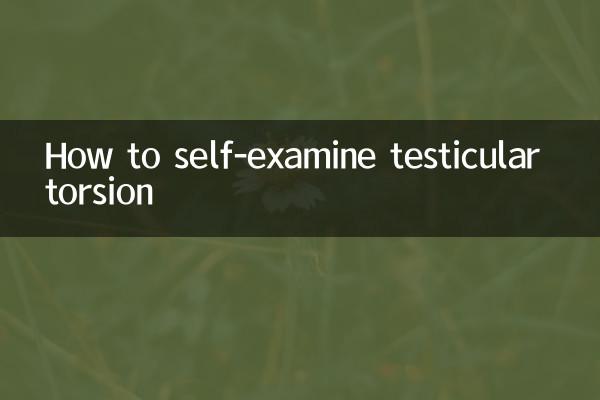How to self-examine testicular torsion
Testicular torsion is an urgent male disease that may lead to testicular necrosis if not treated in time. Recently, in discussions about men's health across the Internet, self-examination methods for testicular torsion have become one of the hot topics. This article will give you a detailed introduction to the symptoms of testicular torsion, self-examination methods and related data to help you quickly identify risks.
1. What is testicular torsion?

Testicular torsion is an emergency in which the blood supply to the testicles is interrupted due to torsion of the spermatic cord. It is more common in adolescents and young men. The following is the discussion data about testicular torsion on the Internet in the past 10 days:
| keywords | Search volume (times) | Discussion popularity |
|---|---|---|
| testicular torsion symptoms | 12,500 | high |
| Testicular torsion self-examination | 8,700 | Middle to high |
| Testicular pain causes | 15,200 | high |
2. Typical symptoms of testicular torsion
The following are common symptoms of testicular torsion. If the following conditions occur, you need to seek medical attention immediately:
| Symptoms | frequency of occurrence |
|---|---|
| Sudden severe pain in testicles | 95% |
| swollen or hardened testicles | 80% |
| Lower abdominal or groin pain | 70% |
| nausea or vomiting | 50% |
3. How to self-examine testicular torsion?
The following are simple self-examination steps to help you initially determine whether testicular torsion may be present:
1.Observe the nature of pain: The pain of testicular torsion is usually sudden and severe and may be accompanied by swelling.
2.Check testicular position: A torsed testicle may be in an abnormal position, such as being elevated or laterally rotated.
3.cremasteric reflex test: Gently touch the inner thigh, and the testicles will shrink under normal circumstances. If the reflex disappears, be alert to twisting.
4.Compare the testicles on both sides: If there is significant swelling or pain on one side, it may be a sign of torsion.
4. High-risk groups for testicular torsion
According to recent medical data, the following people are more likely to develop testicular torsion:
| crowd | risk ratio |
|---|---|
| Teenagers aged 12-18 | 65% |
| Those with a family history of | 30% |
| Those with undescended testicles | 25% |
5. What should you do if you notice symptoms?
If symptoms suspected of testicular torsion are found during self-examination, please take the following measures immediately:
1.seek medical attention immediately: The golden treatment time is within 6 hours after the onset of disease. The testicular survival rate decreases significantly after 12 hours.
2.Avoid taking matters into your own hands: Never apply heat or take painkillers to mask symptoms.
3.Record symptom time: Telling doctors exactly when symptoms started is critical to treatment decisions.
6. Prevention Suggestions
Although testicular torsion cannot be completely prevented, the following steps can reduce the risk:
1. Avoid impact on the testicles during strenuous exercise
2. Wear well-fitting underwear that provides support
3. Understand family medical history and be vigilant
Testicular torsion is a true medical emergency, and prompt recognition and treatment are critical to preserving testicular function. I hope this article can help you better understand this disease and protect men's health.

check the details

check the details